Key takeaways
- Composition in photography involves storytelling, balance, and the interplay of traditional rules and creative spontaneity.
- Techniques such as moving quickly, using natural frames, and adjusting camera settings help capture dynamic moments in real-time.
- Trusting instincts and embracing imperfections can lead to impactful images that convey emotion and authenticity.
- Practicing visual snapshots and experimenting with movement enhances the ability to recognize and compose compelling scenes spontaneously.
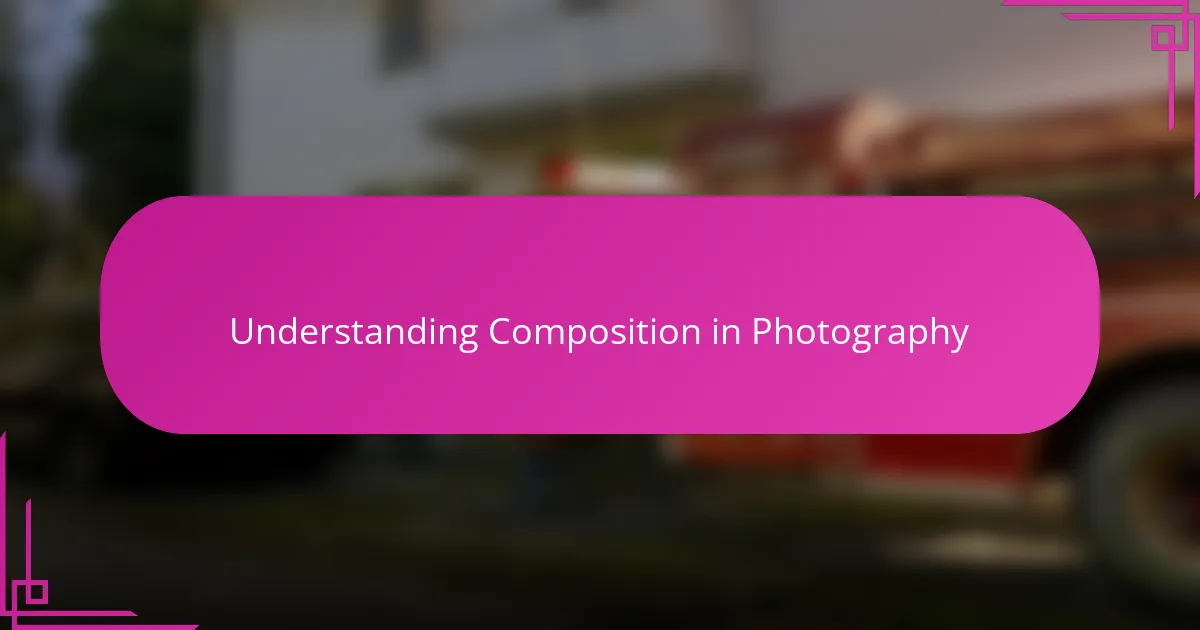
Understanding Composition in Photography
Composition in photography is more than just arranging elements; it’s about telling a story with your frame. I often find myself asking, “What do I want the viewer to feel or notice first?” That question guides my choices almost instinctively.
Over time, I’ve realized composition is a dance between balance and tension. Sometimes, breaking the traditional rules creates a more compelling image because it evokes emotion or sparks curiosity. Have you ever felt that magnetic pull toward a photo that seems imperfect yet perfectly captures a mood?
Understanding composition means knowing your tools—like the rule of thirds, leading lines, or framing—but also knowing when to ignore them. It’s about trusting your eye in the moment, letting intuition play with technique to craft something unique and memorable.
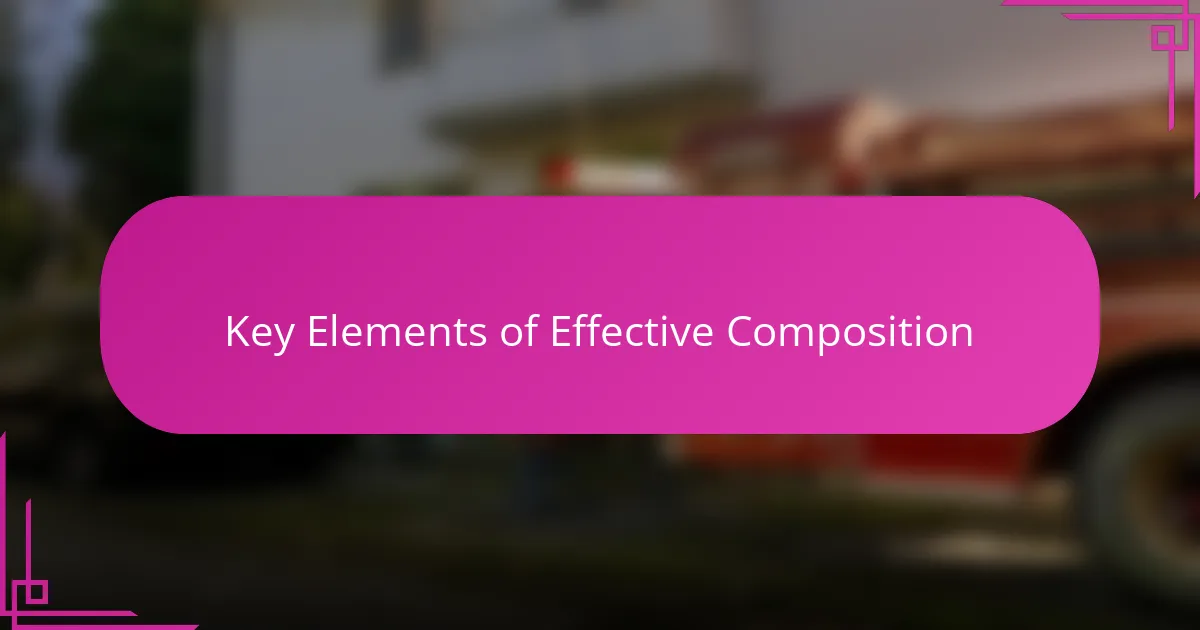
Key Elements of Effective Composition
One key element I rely on is balance—finding harmony between the different parts of the frame. But balance doesn’t always mean symmetry; sometimes, placing a subject off-center creates a dynamic tension that pulls me in. Have you noticed how a slightly off-kilter composition can feel more alive than one that’s perfectly even?
Light and contrast also shape my decisions in composition. When shadows stretch across a scene or highlights catch a texture just right, I instinctively adjust my framing to emphasize those moments. It’s like the light is whispering where I should look, and I try to listen closely.
Texture and patterns often grab my attention, too. I remember once photographing peeling paint on an old door—the irregular shapes created a rhythm that led my eye naturally across the image. When I spot these subtle details, they become the backbone of my composition, giving the photo depth and interest beyond the obvious.
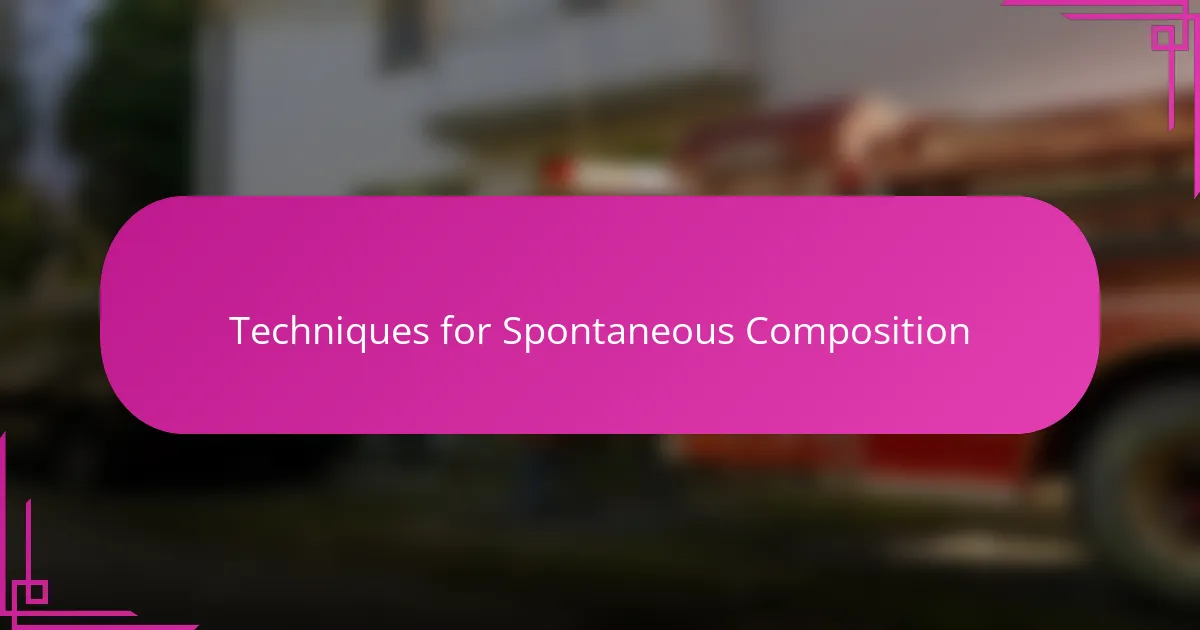
Techniques for Spontaneous Composition
Sometimes, when I’m out shooting, I make a deliberate choice to move quickly and trust my gut rather than overthink the frame. Have you ever caught a fleeting moment where the light shifts just right or a subject’s expression changes in an instant? In those cases, I lean on instinct, adjusting angles or zooming in without hesitating, allowing spontaneity to guide the composition.
I’ve noticed that using simple techniques like framing or leading lines on the fly often helps me capture energy in a scene. For example, spotting a branch arching overhead or a shadow stretching across the pavement can give me a natural frame without planning it out. It’s like seeing the scene’s hidden structure instantly and making it work to my advantage.
Sometimes, I purposefully break the rules when composing spontaneously—cropping tightly or placing the subject awkwardly off-screen. It feels risky, but that unpredictability can breathe life into an image. Have you ever been surprised by a photo you almost didn’t take because it looked “wrong” at first? Those are the moments where spontaneity meets creativity, in my experience.

Tools and Settings for On-the-Spot Decisions
When I’m making on-the-spot decisions, my camera’s settings become my silent partners. I often rely on aperture priority mode to control depth of field quickly without losing focus on the moment. Have you ever found yourself fumbling with dials instead of capturing the scene? Streamlining my tools helps me avoid that.
The zoom ring and focal length play a huge role, too. Sometimes, a subtle zoom-in can isolate a subject just enough to tell a stronger story, while a wider angle invites more context. I remember one afternoon when a quick shift in focal length transformed a chaotic street scene into a powerful frame centered on a single face reflecting determination.
I also keep my ISO and shutter speed dialed in for flexibility under changing light. Adjusting these settings instinctively allows me to freeze action or embrace motion blur without hesitation. This technical freedom feels like having a creative safety net, letting me compose spontaneously without second-guessing if the exposure will fail.
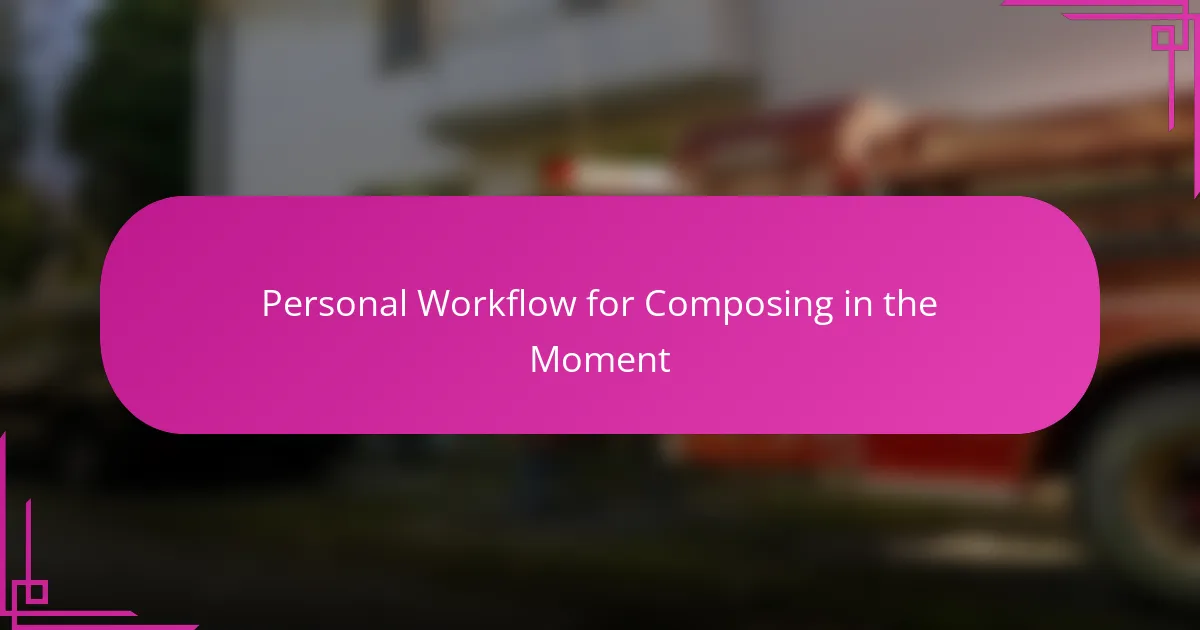
Personal Workflow for Composing in the Moment
When I’m composing in the moment, my workflow begins with a quick mental scan of the scene—I ask myself, what’s the strongest story here? Sometimes it’s a fleeting expression; other times, it’s the way light slices through a shadow. This initial question helps me cut through noise and focus on what truly matters in that instant.
Next, I instinctively move around, experimenting with angles and distances. I’ve found that physically changing my perspective often reveals surprises I wouldn’t have seen standing still. Have you ever crouched low or leaned in closer, only to discover a whole new emotional layer in a seemingly ordinary scene? That movement is crucial for me to feel connected to the composition as it unfolds.
Finally, I remind myself to trust the moment rather than overthink every detail. There was a time when hesitation cost me a perfect shot, and since then, I’ve learned to embrace imperfections as part of the process. It’s in these spontaneous choices that I often capture the raw, honest essence of the scene—something no pre-planned setup could have delivered.
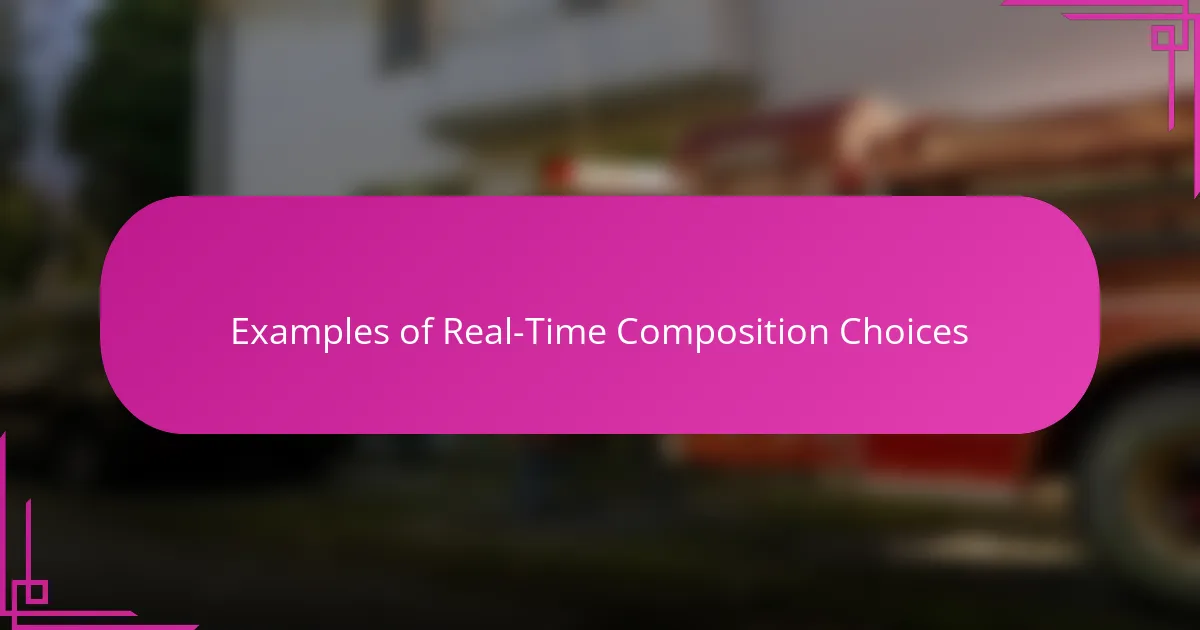
Examples of Real-Time Composition Choices
One time, while walking through a bustling market, I noticed a child’s laughter erupting just as a vendor’s colorful umbrella cast a patchwork shadow on the ground. Without hesitation, I shifted my angle slightly to capture that interplay of joy and pattern. Have you ever felt that split-second urge to reframe not because everything was perfect, but because something unexpected caught your heart?
I often make choices like zooming in tightly on a textured wall when light hits just right, or stepping back to include a passerby whose movement adds tension to an otherwise static scene. These decisions happen in the blink of an eye, driven less by rules and more by what feels alive in that moment. Isn’t it fascinating how a minor shift—just a step to the left or a change in focal length—can transform the entire mood of a photo?
Sometimes, I deliberately crop a subject off-center or let part of the frame remain uncluttered, even if it breaks conventional balance. I recall once shooting a street musician where the shadow of his guitar neck extended beyond the frame, creating a visual pull that drew me in more than a perfectly centered shot would have. Those spontaneous choices often become the heartbeat of my images, revealing stories I hadn’t planned but deeply connect with.
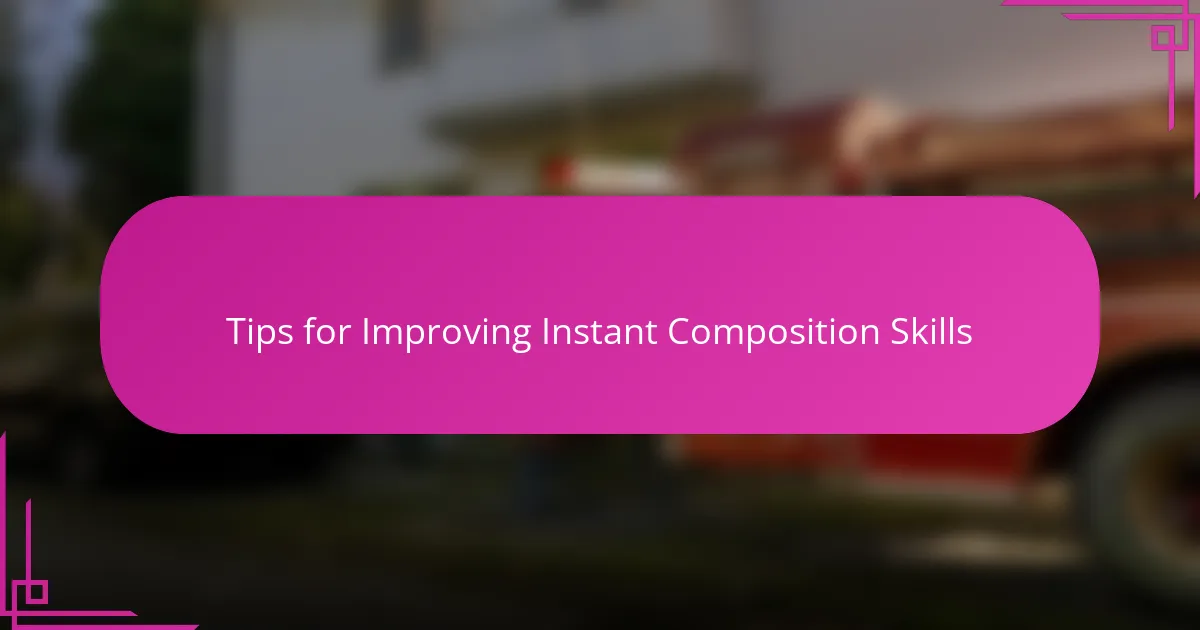
Tips for Improving Instant Composition Skills
One tip that’s helped me sharpen instant composition is practicing “visual snapshots” in everyday life. I challenge myself to quickly frame interesting scenes around me—whether I’m waiting in line or walking the dog—without my camera, just using my eyes. Have you tried this? It trains your brain to spot balance, light, and tension fast, so when you do raise the camera, your instincts lead you.
Another approach I rely on is embracing imperfection. When I hesitate, trying to make everything perfect, I often miss the magic. Instead, I remind myself to shoot first and refine later. Sometimes that means an off-center subject or unexpected background clutter becomes the very element that makes the image feel real and alive. Can you recall a moment when a “flawed” shot turned out to be your favorite?
Finally, I can’t overstate how movement changes composition on the fly. Stepping left, crouching low, or even just shifting your weight can reveal new angles you never noticed at first glance. I often think of it as a dance with the scene, where each step invites fresh possibilities. When was the last time you moved physically to see the world anew through your lens? It’s a simple yet powerful way to improve your eye for instant composition.